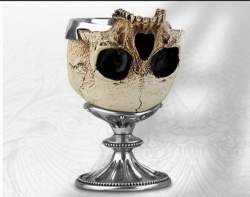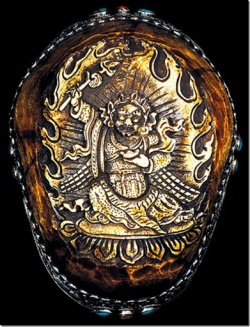Skull cup
A skull cup is a drinking vessel or eating bowl made from an inverted human calvaria that has been cut away from the rest of the skull. The use of a human skull as a drinking cup in ritual use or as a trophy is reported in numerous sources throughout history and among various peoples, and among Western cultures is most often associated with the historically nomadic cultures of the Eurasian steppe.
The (currently) earliest directly dated skull cup at 14,700 BP comes from Gough's Cave, Somerset, England. Skulls used as containers can be distinguished from plain skulls by exhibiting cut-marks from flesh removal and working to produce a regular lip.
The oldest record in the Chinese annals of the skull-cup tradition dates from the last years of the Spring and Autumn period, when the victors of the Battle of Jinyang in 453 BC made the skull of their enemy into a winecup. Later, the Records of the Grand Historian recorded the practice among the ancient Xiongnu of present-day Mongolia. Laoshang (or Jizhu), son of the Xiongnu chieftain Modu Chanyu, killed the king of the Yuezhi around 162 BCE, and in accordance with their tradition, "made a drinking cup out of his skull". According to the biography of the envoy Zhang Qian in Han shu the drinking cup made from the skull of the Yuezhi king was later used when the Xiongnu concluded a treaty with two Han ambassadors during the reign of Emperor Yuan (49-33 BCE). To seal the convention, the Chinese ambassadors drank blood from the skull cup with the Xiongnu chiefs.
In 1510, Shah Ismail I defeated and slew Muhammad Shaybani in battle, founder of the Shaybanid Empire in present day Uzbekistan. The Shah had his enemy's body dismembered and the parts were sent to various areas of the empire for display, while the his skull was coated in gold and made into a jeweled drinking goblet.
In Japan, the famed warlord Oda Nobunaga led a number of campaigns against the Azai and Asakura clans beginning in 1570. Following his victories at the sieges of Odani and Ichijōdani Castles in 1573, he took the skulls of Azai Nagamasa, his father Hisamasa, and Asakura Yoshikage and had them prepared for display and for use as sake cups (o-choko). Unlike skull cups of other cultures, which might resemble a bowl or a chalice in the finished form, the Japanese artisans excised a shallow, saucer-shaped portion from the top of the each skull, then lacquered the skulls, and covered them gold leaf, and each cup was set in the aperture from which it had been cut, concave side up. Nobunaga then presented the three skulls to his vassals and drank sake from the cups, in order to demonstrate the fate of those who would oppose or betray him. ] The three skulls were probably lost when Azuchi Castle was destroyed in 1582.
In India and Tibet the skull cup is known as a Kapala, and is used in Buddhist tantric and Hindu tantric rituals. The skull does not belong to an enemy, and indeed the identity of the skull's original owner is not considered significant, as ritual purity in death has divested the human soul from its corporeal form. Hindu deities such as Kali are sometimes depicted holding a kapala full of human blood. Many carved and elaborately mounted kapalas survive, mostly in Tibet.

